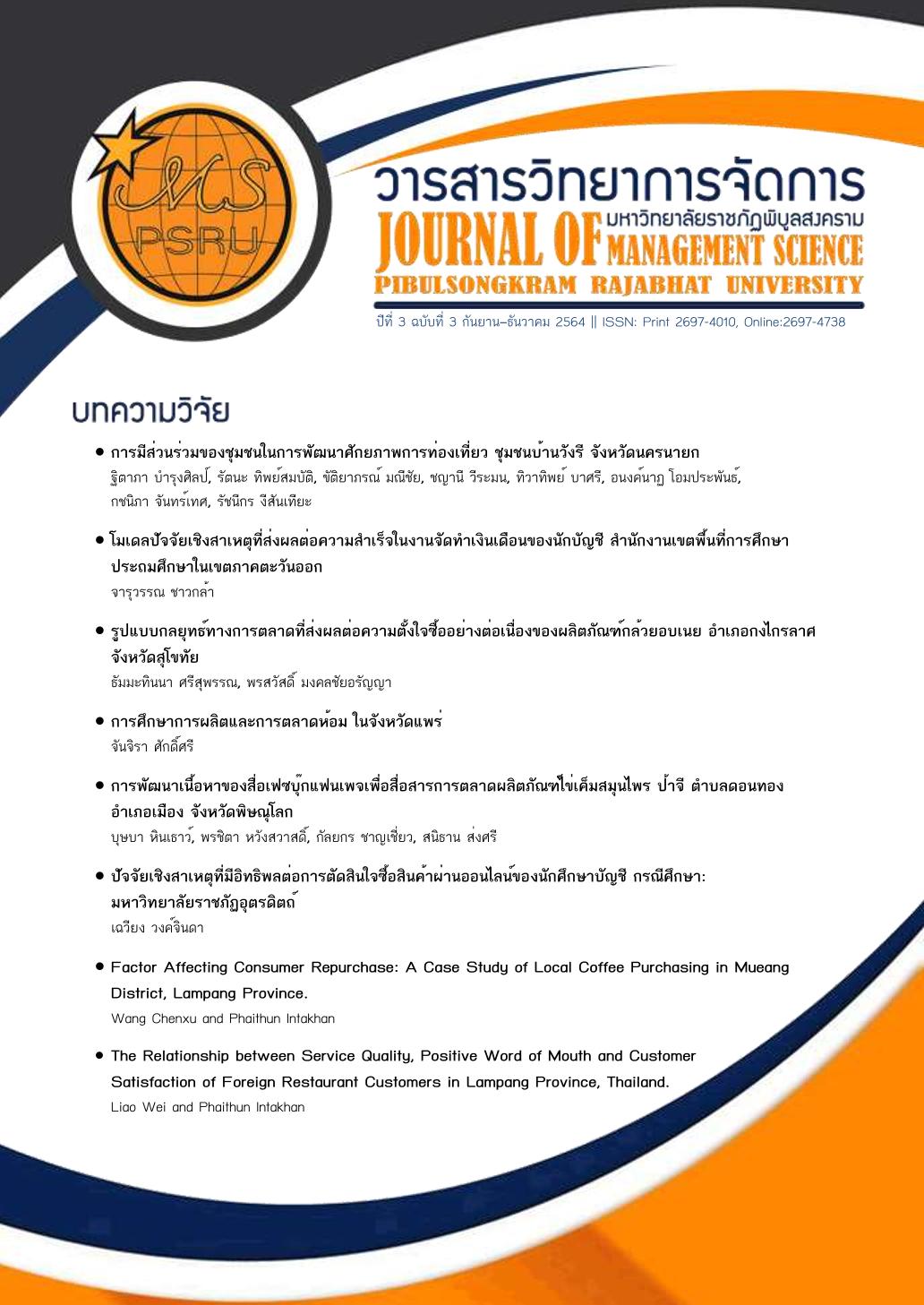Community Participation in Tourism Potential Development of Ban Wangree Community in Nakhon Nayok Province
Keywords:
tourism potential, Ban Wangree Community, Community tourism, Community ParticipationAbstract
The purposes of this study were to examine Tourism potential and Community participants in the Tourism development of Ban Wangree Community in Nakhon Nayok Province. This research is Mixed Method Research based on Quantitative and Qualitative Research. By using observation and in-depth interviews and Survey and Content analysis using frequency, percentage, mean and standard deviation.
The findings indicated that 1) Ban Wang Ri community has potential for tourism development in various fields 1. The tourist attraction is a natural attraction, wisdom, and culture that are unique to the locals. 2. Accessibility Ban Wangree Community urban areas can travel by land transport, Private cars, and vans. 3. Accommodation services the community offers accommodation in both resorts and homestays. 4. Tourism activities Ban Wangree community has a variety of activities organized by the community to welcome tourists. 5. Facilities, the community is well equipped with tourist service facilities, and 6. Tourism management in the community shares the responsibilities of tourism activities and 2) The participation of the Ban Wangree community in tourism development was Overall, was at a high level. When considered on a single side, it was found that the first order was Operations and operations, followed by ideas, planning, and decision-making in the development of attraction potential and tourism monitoring and evaluation in tourism management.
References
กรมการพัฒนาชุมชน. (2563). ชุมชนบ้านวังรี. สืบค้น 12 พฤศจิกายน 2564, จาก http://www.cdd.go.th/wpcontent uploads/sites/110/.2018/07/ชุมชนบ้านวังรี_นครนายก.pdf
การท่องเที่ยวแห่งประเทศไทย. (2558). แผนพัฒนาการท่องเที่ยว ฉบับที่ 2 (พ.ศ. 2560 – 2564). กรุงเทพฯ: สำนักงานปลัดกระทรวงการท่องเที่ยวและกีฬา.
เขมิกา ธีรพงษ์. (2563). การพัฒนาการท่องเที่ยวเชิงวัฒนธรรมด้วยการออกแบบประสบการณ์. ศิลปกรรมสาร, 13(1), 3-15.
จินตวีร์ เกษมศุข. (2557). หลักการมีส่วนร่วมกับการพัฒนาชุมชนอย่างยั่งยืน. พิมพ์ครั้งที่ 1. กรุงเทพฯ: สำนักพิมพ์แห่งจุฬาลงกรณ์มหาวิทยาลัย.
ชัยนุวัฒน์ ปูนคำปีน และชัยพงษ์ สำเนียง. (2563). การท่องเที่ยวโดยชุมชน (Community – Based Tourism) การสร้าง ขยายเศรษฐกิจและวิถีชีวิตท้องถิ่น. สืบค้น 19 พฤศจิกายน 2564, จาก https://prachatai.com/journal/2012/04/39979
เถกิงศักดิ์ ชัยชาญ. (2556). รายงานการวิจัยการพัฒนาคุณภาพการท่องเที่ยวเชิงนิเวศในภาคตะวันออกเฉียงเหนือ. นครราชสีมา: คลังปัญญา มหาวิทยาลัยเทคโนโลยีสุรนารี.
ปาริชาติ วลัยเสถียร และคณะ. (2543). กระบวนการและเทคนิคการทำงานของนักพัฒนา. กรุงเทพฯ: สำนักงานกองทุนสนับสนุนการวิจัย.
วิวัฒน์ชัย บุญยภักดิ์. (2550). ทรัพยากรการท่องเที่ยวของไทย. ใน เอกสารการสอนชุดวิชาทรัพยากรการท่องเที่ยวของไทยสาขาวิชาวิทยาการจัดการ มหาวิทยาลัยสุโขทัยธรรมาธิราช. นนทบุรี: มหาวิทยาลัยสุโขทัยธรรมาธิราช.
Shirley, E. (1992). My travels around the world. Newton Aycliffe, UK: Heinemann.
Yamane, T. (1973). Statistics: An introductory analysis. New York: Harper and Row.
Downloads
Published
How to Cite
Issue
Section
License
Copyright (c) 2021 Pibulsongkram Rajabhat University

This work is licensed under a Creative Commons Attribution-NonCommercial-NoDerivatives 4.0 International License.
บทความที่ได้รับการตีพิมพ์ในวารสารวิทยาการจัดการมหาวิทยาลัยราชภัฏพิบูลสงคราม เป็นลิขสิทธิ์ของมหาวิทยาลัยราชภัฎพิบูลสงคราม
บทความที่ลงพิมพ์ใน วารสารวิทยาการจัดการมหาวิทยาลัยราชภัฎพิบูลสงคราม ถือว่าเป็นความเห็นส่วนตัวของผู้เขียนคณะบรรณาธิการไม่จำเป็นต้องเห็นด้วย ผู้เขียนต้องรับผิดชอบต่อบทความของตนเอง


